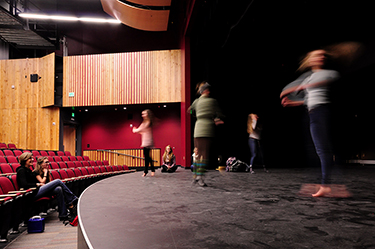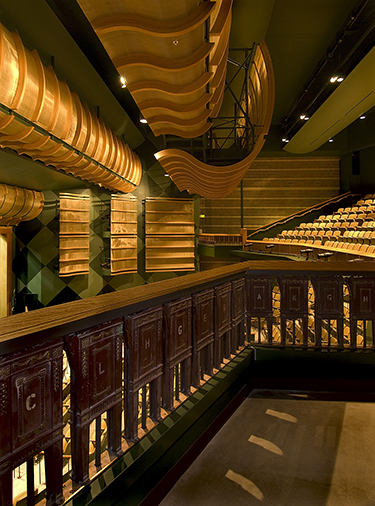|
Subscribe / Renew |
|
|
Contact Us |
|
| ► Subscribe to our Free Weekly Newsletter | |
| home | Welcome, sign in or click here to subscribe. | login |
Construction
| |
 |
August 28, 2014
Can you design a school theater that pleases everyone?
Sparling

Yantis
|
Educators and design professionals are taking a fresh look at the architecture of high schools in an effort to align education with the skills needed for our country to compete globally.
Although some of this creativity has been directed at the design of high school theaters, current designs remain remarkably close to those created 50 years ago. With few exceptions, most high schools contain a proscenium-style theater with full or partial fly loft to seat an audience of 500 people.
Questions to consider
Perhaps the consistency of the design of the performing arts facility is because it still effectively serves its mission. However, to be consistent with the creative thinking that is modifying K-12 architecture, is it time to take a fresh look at high school performing arts facilities design?
If so, there are a few fundamental questions:
• What purposes will the performance space serve for the school? For the community? Is the emphasis on drama or music? What size audience is expected most often? If we add to the number of performance spaces, what other academic functions can they fulfill?
• Broadway-style musicals generally require a proscenium theater with a fly loft. It is often a busy, highly utilized space. But it is also expensive and the seating area is often not used during daytime school hours. Can we achieve the educational goals associated with the performing arts without it? If there were more, smaller performance spaces, could they properly serve the performance and rehearsal goals for the school? Would we need to modify a larger space such as the commons to serve as a performance space for large audiences?
• Will the need to be more economically efficient in the performing arts change professional venues? How might those changes drive the need to change the way performing arts are taught and performed in high school?
Competing goals
Most high schools do not have separate performance spaces for music and speech.
They have a multipurpose proscenium-style theater used for both music and drama. However, the acoustics of a space intended primarily for music are much different from a space dedicated to speech.
They have opposite acoustic goals. A space for speech should be acoustically dry with very little room response so the content of the speech can be easily understood. A lively room can blur speech and make it difficult to understand.
On the other hand, music played by a full band or orchestra depends on its environment to add to the content of the music. It requires the room to add reverberance, spaciousness and a sense of envelopment in order to create an experience that transcends the mere content of the music.
Imagine listening to a string ensemble in a chamber music hall as opposed to listening to the same music outdoors. We might enjoy the weather outside, but the music suffers. The venue has to complement the music.
By definition, then, a theater used for both drama and music has conflicting acoustic goals. If the space is optimized for speech, the music suffers. If it is optimized for music, speech can be difficult to understand, particularly without an excellent sound-reinforcement system and an equally qualified sound operator.
Most often, high school projects attempt to find a proper physical compromise between these two acoustic extremes, adding volume and proper shaping to the room to support music while not pushing the design so far as to impair speech. This technique can produce an acceptable environment for both music and speech.
Two examples of high school theaters that have found this optimum balance are at Roosevelt and Vashon high schools. Both theaters effectively support their school’s drama and music programs and are very well-received. For reference, Roosevelt seats 750 and Vashon seats 230, both different from the most common seat count of 500.
But even if the design team hits a bullseye, the result, although acceptable, is not optimum for either drama or music. This creates additional questions:
• Does a good but not great environment sufficiently serve the theater’s purpose? Does the level of performance warrant better spaces? This is a reasonable question for music, but to the extent that speech intelligibility is not ideal in a multipurpose hall, it is easy to argue for a space optimized for speech alone.
• Would a space with great musical acoustics better inspire future professional musicians? Similarly, would a space optimized for drama better serve the academic mission related to the theater arts?
• Can we afford to build spaces more aligned with each acoustic extreme?
Is there a better way?
If the performance venues associated with a high school are to be recreated, a vital part of the team would be the arts staff of the school. They may not know how to create what they need, but they have the best knowledge of what they do, how they do it and what they need.
Questions about who will operate the theater after construction are equally important. A theater is like an instrument that the staff needs to learn to play to bring out the best it can offer.
Part of the educational aspect of the theater is its operation.
With respect to acoustics, a gifted person working the sound-mixing board is akin to a virtuoso violinist. He or she can “play” the room, maximizing its assets and minimizing its liabilities. A less gifted person could struggle with the same room, creating liabilities and minimizing assets.
This is particularly problematic in a multifunction theater where the acoustics of the room has been pushed for the benefit of music and the intelligibility of speech is at least partially dependent upon the design of the sound system and the capability of its operator.
The design team can provide a venue that finds the perfect balance of music and speech, but an unskilled sound board operator might not be able to measure up to the room’s demands. A high school student as board operator, a common position and one that is part of the educational goals of the performing arts, would not often have the experience to truly optimize speech intelligibility in a hall that has been pushed to provide desirable musical acoustics.
Although the current high school proscenium theater serves its mission, can we do better? If we can do better, can we create performance spaces that improve their performance characteristics but don’t cost appreciably more? Perhaps, if talented design professionals and educators tackle the task.
It would at least be fun to consider.
Michael R. Yantis is principal of acoustical design and consulting at Sparling.
Other Stories:
- What schools can learn from Starbucks
- Renton preschool offers kids a running start
- How replacing an old building is like selling New Coke
- Locals designers help rebuild schools in Haiti damaged by earthquake
- What to consider when building a new school next to the old one
- WSU technology lab combines work with show
- Do art and science mix? Lab designers give it a try




